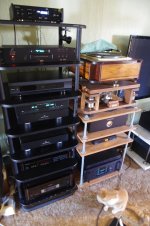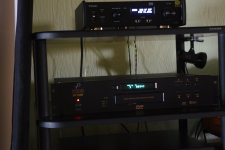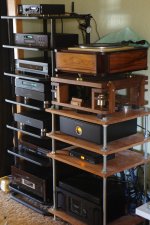Albert
New member
- Thread Author
- #1
I am breaking in a new Teac UD-503 DAC with an Oppo BDP-95 as a transport connected by a Black Cat Silver Star 75 digital coax cable. Being home sick with the flu today I thought why not try using one of my old Faroudja DV-1000 DVD players as a transport. It is a well built unit and sounded very good as a CD player in it's day. I figured even if the DAC is old, the transport is still well made.
So I rearranged the system and substituted the Faroudja for the Oppo. It actually sounds better to me. The cymbals that sounded a bit too hot (sizzly) now shimmered and everything seemed more in balance. It even sounded warmer to me, how could that be from a transport? I am not sure why there is a difference but I am going to keep the Faroudja in the system. Hopefully when my Calyx Femto arrives i will find the same results.
Here are a few snaps of my newly configured system with the Faroudja DV-1000.



So I rearranged the system and substituted the Faroudja for the Oppo. It actually sounds better to me. The cymbals that sounded a bit too hot (sizzly) now shimmered and everything seemed more in balance. It even sounded warmer to me, how could that be from a transport? I am not sure why there is a difference but I am going to keep the Faroudja in the system. Hopefully when my Calyx Femto arrives i will find the same results.
Here are a few snaps of my newly configured system with the Faroudja DV-1000.



